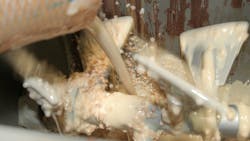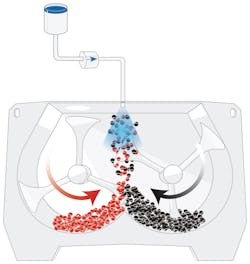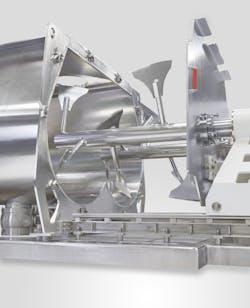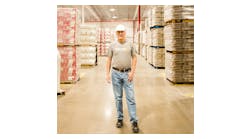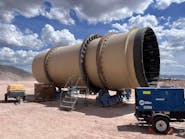How powder properties impact bulk solids mixing processes
Mergers and acquisitions in the food, chemical, pharmaceutical and other industries often trigger the sale of process equipment that may work perfectly but is suddenly deemed unnecessary as product lines are trimmed and/or production capacity is shifted among different facilities. This happened recently at a snack manufacturing company, whose owner was wondering why the Gericke stainless-steel mixer he had recently acquired due to a plant closure would not mix his milled sugar and other ingredients with perfect homogeneity in 30 seconds or less as stated on the website.
Using the mixer’s serial number to review its design specifications and targeted homogeneity, it was clear why performance was inconsistent. The mixer had been designed to mix a light product with several minor and micro ingredients, both liquid and dry; it had not been designed for milled sugar. Milled sugar has key differences in bulk density, particle size and moisture content from the material the mixer was designed to process. If a mixer is designed specifically to achieve a given level of product quality based on a given set of input parameters, then altering any one of the input parameters can significantly alter the resulting output and may even damage the mixer.
Bulk density
The bulk density of milk powder is 0.55 g/cm3, and the bulk density of sugar is 0.90 g/cm3. If a mixer designed for sugar is fed a very low bulk density material such as fine milk powder, it is unlikely to encounter a serious problem, all else being equal. But if a mixer designed for a low bulk density material is fed a very high bulk density material such as sugar, then the mixer will likely struggle. The additional strain on the paddles, shafts, bearings and other mechanical parts that were specified for lighter duty may hinder performance or cause outright breakage, failure and downtime. The motor, specified to deliver 15 kW of power, for example, may fail when required to mix denser materials and thicker mixtures for which a 22-kW motor would have been specified. As the underpowered motor runs under the heavier-than-anticipated load, it also generates unplanned-for heat that could affect product quality.
Temperature
The material’s temperature as it enters the mixer typically must be identical for each batch, or at all times for a continuous process. Consider a material stored in sacks at 68°F then heated to 100°F enroute to loading into the mixer, as per the recipe, and as per the system design. Everything works as intended until a failing thermostat on the oven allows the material to be heated to 200°F as it enters the mixer despite reading near 100°F. Temperatures as high as 200°F can soften many materials and drastically change their characteristics. A previously warm, dry powder can suddenly enter the mixer hot and semi-viscous, completely changing the process design requirements. Very few recipes can accommodate such an ingredient substitution, and it is highly unlikely that the product at discharge would meet the targeted specifications.
In addition to wasting valuable ingredients, loading materials at higher temperatures than the mixer was designed to handle can cause mechanical issues and, eventually, a costly failure. Consider a mixer designed to operate with a clearance of 6 millimeters between the mixing paddles and the interior wall of the mixing chamber for optimal performance based on the recipe and targeted homogeneity. If one or more ingredients are loaded at unexpectedly high temperatures, the added heat could cause thermal expansion of the fabricated metal or stainless-steel body and internal components. This expansion will stress seals and could shrink the 6-millimeter clearance between the mixing paddles and interior wall to just 3 millimeters. This change from the original design specification can alter many process parameters, including increasing the time required to achieve a desired mixture or even negatively impacting the blend’s particle size or consistency. Conversely, a material entering the mixer at a temperature much lower than specified can cause problems with flowability and the contraction of mechanical parts.
In systems using a rotary valve to feed a mixer, thermal expansion due to an unexpectedly high material temperature can cause the spinning rotor to come into contact with the valve housing. This can create metal flakes that contaminate the mixture, along with potentially dangerous mechanical failure. Recent advances in rotary valve design, however, automatically detect this type of metal-to-metal contact and shut down the drive system before a serious failure can occur. However, unless the material is consistently fed at the proper temperature, the rotary valve is likely to experience leakage and the risk of premature failure.
Moisture content
Suppose the owner of a wholesale bakery stocked up on flour, sugar, corn starch and other major ingredients during the winter and stored the 50-pound sacks at approximately 68 degrees. Once the dry, wintry air gave way to the heat and humidity of summer, the ingredients began to absorb some of the ambient moisture, raising the moisture content from the three percent specified in a key recipe to five percent. For many materials, this seemingly small increase is large enough to increase the particle size, distort the particle shape, and cause enough agglomeration and bridging to clog rotary valves, conveyors, feeders and other equipment.
Once fed into the mixer, a material with a moisture content above the specified range of the mixer design may leave unmixed lumps, displace wet materials in the reaction, cause excess vapors if heated and/or other issues, and the product will be out of spec for the next operation downstream. If the particle size specified is 1 millimeter for granulated sugar, for example, but the particles fed into the mixer are agglomerated and reach up to 4 millimeters, the sugar may or may not deagglomerate and the recipe is likely to fail regardless of the type of mixer. An inline sifter and/or lump breaker may be used upstream to return the sugar to the proper particle size, but it is more efficient to prevent the moisture issue by storing the materials in a climate-controlled location and maintaining the proper moisture content throughout the process. A hand-held or inline moisture analyzer can be used to check the material’s moisture content as it leaves storage and at every stage of the process, if needed, to verify that it meets the conditions specified.
Cleaning
Water is often considered the worst enemy in powder processing, and residual moisture from the cleaning process can affect powder properties in the same way as ambient moisture from humidity — if not worse. Nearly every plant shutdown due to bacterial contamination can blame water to some degree for inviting bacterial growth into the process. In some cases, residual moisture left in the mixer, conveyor or other equipment after cleaning can be identified as the culprit causing the downtime.
Recent high-profile plant shutdowns traced to bacterial contamination are accelerating the adoption of a dry process for cleaning mixers and other equipment between batches rather than the traditional process using a chemical wash, water rinse, and hand drying. Any moisture left on the infeed, mixing tools or anywhere in the mixer interior acts as another ingredient to be mixed and may cause unintended consequences beyond a poor-quality mix. A variety of mixer designs, for example, can trap this residual moisture within joints and fasteners and allow it to promote the growth of bacteria, ultimately providing yet another ingredient to be mixed into the recipe. In this case, the result could mean contamination, a product recall and several weeks of downtime to identify the source and resolve the issue.
Given the investment involved in an automated mixer or an entire processing line, it is critical to specify equipment designed to optimize the process for peak efficiency and product quality. But that is not enough. It is also critical to ensure that the materials are presented to the mixer at the proper temperature, moisture content and other parameters to achieve the targeted mixing speed and homogeneity.
Rene Meira Medina is executive vice president of Gericke USA. Founded in 1894, the company designs and manufactures a wide range of mixers, lump breakers, pneumatic conveying systems and other powder processing equipment.
Gericke USA
